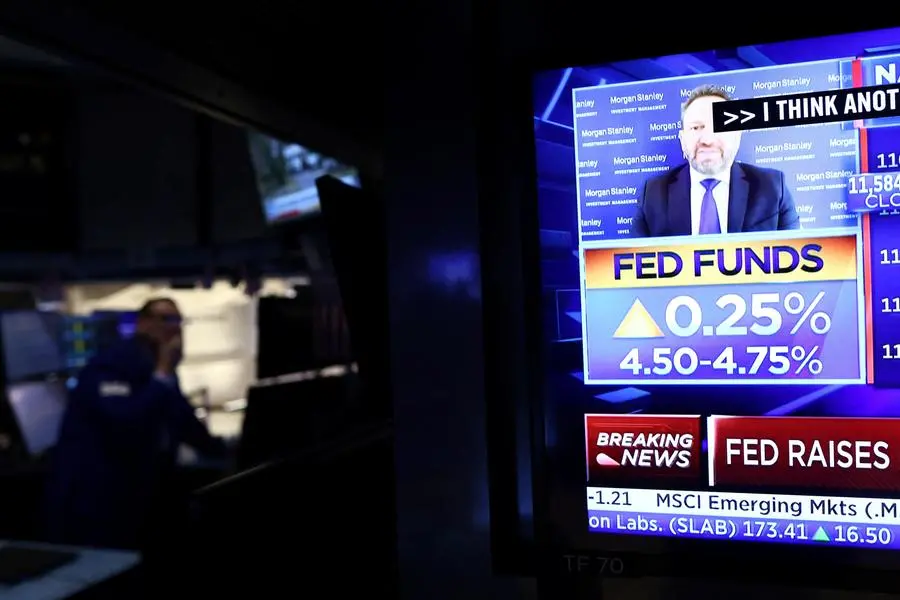PHOTO
A more dovish-than-expected message from Federal Reserve Chairman Jerome Powell stands to further boost hopes of slowing rate hikes and a so-called economic soft landing that have fueled a powerful rebound in U.S. stocks.
For weeks, hopes that easing inflation and cooling growth will allow the Fed to pull back from its hawkish monetary policy outlook have boosted stocks and other risk assets after a brutal 2022.
Many on Wall Street remain convinced that a widely expected recession is likely to roil markets once again sometime this year. Bullish investors, however, took heart at Powell's comments at the end of Wednesday's monetary policy meeting, when he acknowledged progress in the fight against inflation and appeared reluctant to push back against the rally in stocks and bonds.
"At this point, the market has welcomed the fact that a couple of more increases at 25 basis points basically means just marginal adjustments," said Alessio de Longis, senior portfolio manager at Invesco Investment Solutions. "The light at the end of this monetary cycle is coming."
De Longis is betting on more gains in many of the asset classes that have thrived in recent weeks, including shares, emerging markets and higher-yielding debt.
The S&P 500 rose more than 1% on Wednesday, and is now up more than 7% for the year. Yields on the benchmark U.S. 10-year Treasury, which move inversely to prices, fell after the meeting and have declined by more than 40 basis points in 2023.
To be sure, Powell gave little indication that the Fed was close to veering from its rate hike trajectory after it announced a widely expected 25 basis point rate increase. He said "a couple more" rate increases likely lay in store.
Still, Garrett Melson, portfolio strategist at Natixis Investment Managers Solutions, said the market was cheered by the lack of "hawkish pushback" on the broad-based rally in risk assets, which some worry could make it harder to contain inflation. Also encouraging for investors was Powell's repeated references to disinflation - a falling rate of inflation.
The monthly rate was negative in December, when consumer prices were 0.1% lower than in November. It was the first fall since May 2020.
"I think they do see a path where you can get that soft landing, that Goldilocks-type scenario play out," he said.
SKEPTICISM
Plenty of investors nonetheless heard a less dovish message from Wednesday's meeting, with many skeptical that policymakers would be able to bring down the highest inflation in decades without hurting the economy.
"We think that the final way that we will get inflation all the way back down to the end target will almost necessarily require a recession, albeit a short and shallow one," said Kristy Akullian, a senior strategist with BlackRock's iShares Investment Strategy team.
Banks and asset managers that have reiterated recession calls in recent weeks include BlackRock, Wells Fargo and Neuberger Berman.
Meanwhile, a key part of the Treasury yield curve, which inverted in March last year for the first time since 2019, remained deeply in negative territory, with yields on shorter-dated debt standing above those on longer-dated bonds, a time-honored recession signal.
Others said that while futures markets were pricing the Fed's key policy rate peaking at around 4.88% in June - a peak that is lower than the 4.91% priced before the meeting - and falling in the latter half of the year, rate cuts would likely come that quickly only if the economy fell into recession.
The Fed has projected it will raise its key policy rate to between 5% and 5.25% and keep it there at least until the end of the year, and Powell insisted on Wednesday that rate cuts were not in the offing.
"Do people think (rate cuts) will be in response to inflation that has been coming down or something more dramatic, in terms of economic slowdown? I would think the latter," said Fran Rodilosso, head of fixed income ETF portfolio management at VanEck.
Nevertheless, some investors are happy to run with the more dovish scenario, especially if inflation keeps slowing. Ed Al-Hussainy, senior interest rate strategist at Columbia Threadneedle, is starting to pull back on hedges in futures markets that would pay off if rates hit 5%.
"We have a huge change in the Fed's willingness to look at both sides of the inflation data and this time recognize that disinflation is happening," he said. "It sounds like they are very much done."
(Reporting by Davide Barbuscia and Lewis Krauskopf; Writing by Ira Iosebashvili; Editing by Megan Davies)





















